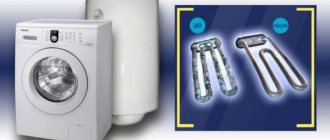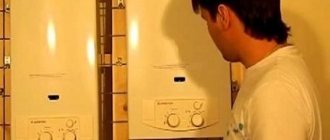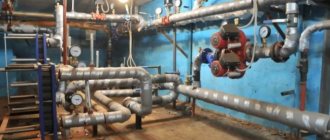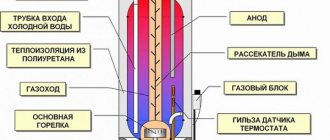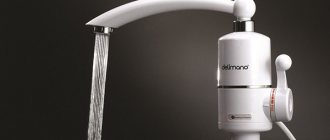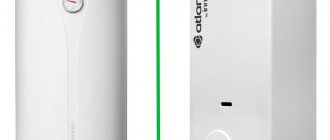User's manual
Before starting to use the water heater, general information about such devices is studied: how they are connected, where it is better to establish what properties they have. Then you need to read the instructions for use:
- After installing the boiler, it is necessary to remove air from the tank, for which the mixer taps are opened. After a while, water will flow from them.
- To set the required temperature value, use the thermostat knob. It is located on the front of the tank - on the control panel.
- Automatic shutdown of equipment occurs when the liquid inside is heated to a predetermined temperature value (+ 74 ... + 93 ° С). As the temperature cools down, the thermostat records all changes in the water parameters, it triggers to turn on the water heater when the liquid cools down.
- In order to save money, it is impractical to disconnect the device from the network if it is constantly in operation.
Safety rules during operation
The following rules must be observed, which are spelled out in the operating instructions.
Prohibited:
- Connect the device to the mains if there is no liquid in the tank.
- Attempt to remove the cover plate while the device is plugged in.
- Use the EVN when it is not grounded.
- Use the device when the water pressure in the line is more than 0.6 MPa.

Boiler safety group with pressure indicator
- Use the water that has passed through the EVN for cooking.
- Use spare parts that do not meet the recommended specifications.
- Use water containing sand or other particles.
- Modify the fastening design.
- To extend the service life, it is strongly recommended to clean the tank, followed by changing the protective anode once a year. And if you have very hard water and the device works constantly, it is necessary to carry it out every six months.
- Plug in the device
- Set a comfortable temperature. Depending on the device you are using, mechanical or electronic, there are two ways to adjust the water temperature.

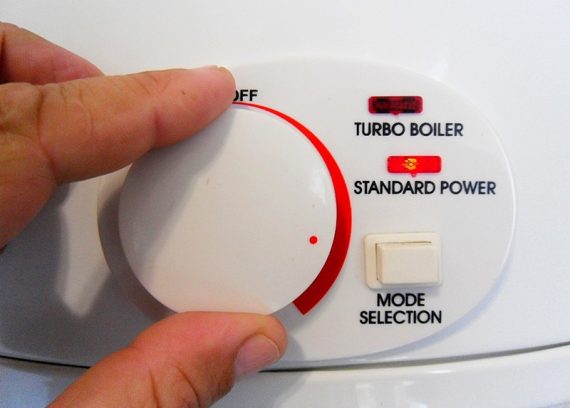
Heating temperature control
For example, in the thermex bio glasslined range, the temperature is controlled by rotating a mechanical relay, while in the thermex stainless g.5, to set the temperature, you need to press the up arrow on the display and hold it until it reaches the desired value.The optimal heating temperature is 45-55 degrees, this range will save the heating element from the formation of plaque. Also in this model it is possible to use an economical mode, using one heating element.
- Wait until the water is heated.
Reception of water procedures:
Installation and connection
The installation and first start-up must be carried out by qualified people.
If you nevertheless decide to do it yourself, learn how to install and connect the EVN. Please be aware that self-installation may void the factory warranty.
It is advisable to install the installation as close as possible to the place of use in order to avoid heat loss. The wall should be selected taking into account the total weight of the charged electric water heater. If the wall is weak, it needs to be strengthened. For fasteners, standard fasteners are used. The floor in the room where the heater is installed must be waterproofed with water drainage into the drain. As a last resort, you can install a pallet under the unit with a drain into the sewer. The EVN drain valve must also have a water drain.
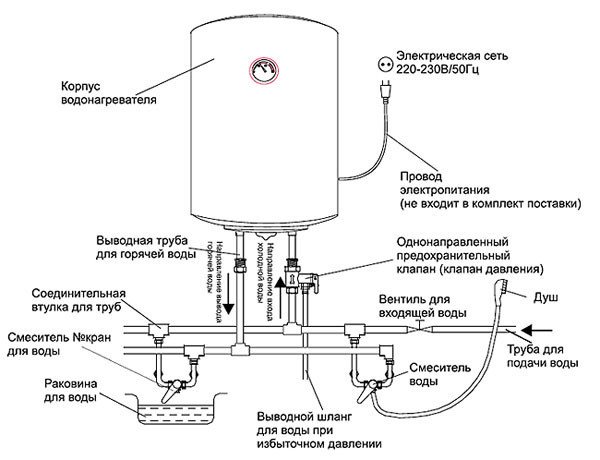

Connection diagram of the Termeks water heater to the water supply system.
Connection to the water supply is carried out through a filter, the degree of purification is no more than 200 microns. All joints are sealed with flax or FUM tape. After that, the boiler is filled with water, for this, the hot water tap of the mixer is opened, then the inlet valve. To prevent increased pressure from forming in the tank, periodically open the mixer tap for hot water. After the water has flowed from the tap of the mixer, it is closed (the tank is full).
Connection to the electrical network is carried out using a standard cord with a plug. The socket must provide grounding, a three-core cable is connected to it ("phase", "zero", "ground"), the cross-section of copper conductors with a heating element of ≤8 kW should be at least 4 mm2, with a higher power - at least 6 mm2.
Typical malfunctions of the "Termeks" heater
The wide range of Thermex allows you to choose a boiler for 100 liters for a large family, for 10-15 liters for use in a small kitchen, etc. The device is a metal heating tank with a heating element inside. The heater is controlled by a relay and a thermostat. The magnesium anode helps soften the tap water.
It should be noted that modern water heaters are equipped with a control unit that has a self-diagnostic function. The system identifies the faulty unit and displays an error code. Having deciphered the meaning, you can understand where to look for a breakdown and how to fix it yourself.
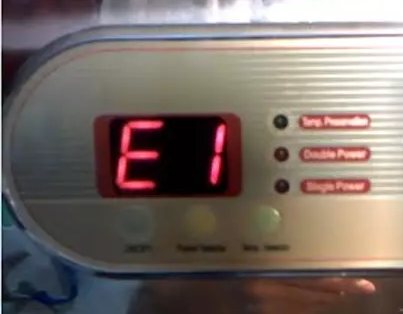

Error table for water heaters "Termeks"
| Error codes | What does | How to fix it yourself |
| E1 (Vacuum) | Insufficient filling of the tank with water. Premature inclusion. | This can lead to the combustion of the heating element. To correct the situation, turn off the device and wait for normal filling. Then reconnect. |
| E2 (Sensor) | There are problems with the thermal sensor. | Try to disconnect the boiler from the mains by performing a reboot. If after that the code is highlighted again, then ring the sensor with a multimeter, and in case of a malfunction, replace it. |
| E3 (Over Heat) | This error indicates that the water has heated up to a critical temperature (95 degrees). | The thermostat may have broken. Replace it. |
The video will help you deal with the E1 error:
Other problems occur in the electric water heater:
- The appliance does not heat up the water or does it for too long.
- Noise is heard during operation.
- Runs only for a short time.
- Does not work, does not turn on.
- The tank is dripping.
- Unpleasant smell and color of water.
If you notice one of the signs, then proceed to check and repair.
Search for the cause of the breakdown
Before starting repairs, you need to find out what is the cause of the problem.
This can be understood beforehand without disassembling the device itself.
The main malfunctions of electric water heaters are:
- the device does not turn on;
- short circuit protection (RCD) is triggered;
- the water heater does not heat the water, or does not comply with the heating rate;
- the boiler leaked.
If a leak appears, it is necessary to find out where it is flowing. If the heating element gasket has leaked, then such a defect can be easily eliminated. You just need to replace it with a new one, especially since they cost a penny.
It should be noted: if water drips from the very body of the water heater, then it will probably be easier to buy a new device, because such a defect is practically irreparable.
In water heaters, first of all, water heating elements - heating elements - fail, since they are the main working element of the structure.
You can find out how to make the right choice of a water heater and not be mistaken here:
It is possible to preliminarily understand that it is the heating element that has failed by the following indirect signs:
- protective automatics are triggered;
- knocks out the machine on the counter;
- water does not heat up, or the device heats up poorly;
- the hissing of the water heater and the release of water of a cloudy consistency with an unpleasant odor.
With such symptoms, the most likely is the failure of the heating element. This can be determined by the appearance of the heating element itself - the shell is damaged.
Sometimes the heating elements burn out without visible damage to the shell, then this can be determined using a tester.
If the ohmmeter shows infinity at the terminals, then the nichrome spiral is broken.
If zero, then there is a short circuit somewhere. In any case, such an element needs a replacement.
In some cases, the heating element fails for the following reasons:
- The heating element has fulfilled its term;
- the unit was turned on without water;
- the water heater was turned off for a long time, but the water was not drained;
- sudden voltage drops in the network.
In any case, the heating element needs to be changed. Of course, the easiest way is to use the services of a master, but it is quite possible to change the heating element yourself. It is necessary to warn that the repairs must be done in a certain sequence so that there is no confusion. This is an important precondition for a successful renovation.




